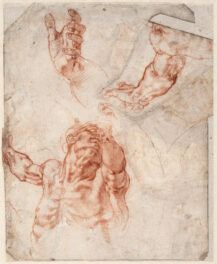The Augsburg Display Cabinet—the Getty Museum’s 17th-century “cabinet of curiosities” on display starting tomorrow in our New Galleries for Medieval and Renaissance Sculpture and Decorative Arts—is both a work of art and an early prototype of museums. With dozens of compartments to store collectibles, this remarkable object unfolds in myriad ways to reveal surprising treats for the eye.
Like a museum, it was used to store, organize, and display a prized collection of works of art and natural objects. By opening its many doors and drawers, the original owner could embark on a labyrinth-like journey, admiring tiny oil paintings, wood carvings, and precious inlaid materials decorating its surfaces—much like the voyage of exploration and discovery experienced in a museum visit.
In its time, the cabinet offered innovation and trompe-l’oeil allure not unlike the cutting-edge technology—augmented reality (AR)—that we’re using today to allow modern-day viewers to explore this intricate object without actually touching it.
To simulate the cabinet, our AR feature at www.getty.edu/collectorscabinet consists of a Web page that displays a 3-D, miniaturized model overlaid on a live video feed from the viewer’s webcam. The user feels a sense of engagement by seeing himself or herself in the live video feed, and by controlling the cabinet’s movement—opening, spinning, and tilting it like its original owner could.
The Augsburg Display Cabinet AR feature is intended to generate excitement for what museums are all about: discovery and wonder. In the gallery viewers can’t touch the real cabinet. With augmented reality, barriers to the imagination fall away.




This is fascinating! AR technology has nearly unlimited applications, but costs can be prohibitive. Can you reveal how the AR project was funded?
Greetings Adrianne,
Maria from Collection Information & Access at the Museum here. The AR feature was sponsored internally and essentially grew out of another project. We created a 3-D digital model of the Augsburg cabinet for an in-depth interactive used in-gallery adjacent to the object and online, and we were able to draw upon this material to develop the AR experience. If you explore the interactive, you’ll see that it includes the same views but the user has many more choices to manipulate the cabinet. One can open individual doors and drawers, zoom in to take a closer look, identify the materials, etc. If you’re interested in nitty gritty details, we share information about our technological projects in the Museum Computer Network (MCN) Musetech Central Project Registry and the Augsburg Cabinet Augmented Reality (AR) Feature is included there. Thanks so much for your interest!
– Maria
The interactive cabinet is really fascinating although it took a very long time to load (about 4 minutes on my laptop)
It reminded me of the Google Art project where they digitize pictures in such a great detail that viewers online are able to find details that were hidden for centuries from the eyes of people who were actually standing right in front of it.
Anyway, will there be more presentations like this one in the future?
Li Chin – Berlin, Germany